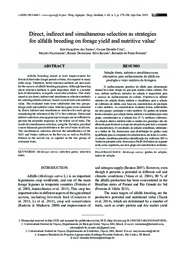Direct, indirect and simultaneous selection as strategies for alfalfa breeding on forage yield and nutritive value.
Direct, indirect and simultaneous selection as strategies for alfalfa breeding on forage yield and nutritive value.
Author(s): SANTOS, I. G. dos; CRUZ, C. D.; NASCIMENTO. M.; ROSADO, R. D. S.; FERREIRA, R. de P.
Summary: Alfalfa breeding aimed at trait improvement for livestock feed takes longer periods of time, if compared to many other crops. Therefore, better selection methods are necessary for the success of alfalfa breeding programs. Although knowing about selection methods is quite important, there is a notable lack of information, as regards successful solutions. This study aimed to use direct, indirect and simultaneous selection methods for selecting alfalfa cultivars, based on yield traits and nutritive value. The evaluated traits were subdivided into two groups: forage yield and nutritive value. Selection gains were estimated by direct, indirect and simultaneous selection for each group, considering the selection of the 25 % best cultivars. Direct and indirect selections among genotype averages are not efficient to provide the desirable responses to the whole set of traits. The results for simultaneous selection, using the Tai index, provided a more balanced gain distribution to the set of traits in all cuts. The simultaneous selection allowed the identification of the 5681 and Verdor cultivars in the first cut, as well as ProINTA Patricia in the second cut, as superior in the two groups of evaluated traits.
Publication year: 2018
Types of publication: Journal article
Keywords: Alfafa, Alfalfa, Alfalfa breeding, Cultivares de alfafa
Observation
Some of Embrapa's publications are published as ePub files. To read them, use or download one of the following free software options to your computer or mobile device. Android: Google Play Books; IOS: iBooks; Windows and Linux: Calibre.
Access other publications
Access the Agricultural Research Database (BDPA) to consult Embrapa's full library collection and records.
Visit Embrapa Bookstore to purchase books and other publications sold by Embrapa.

